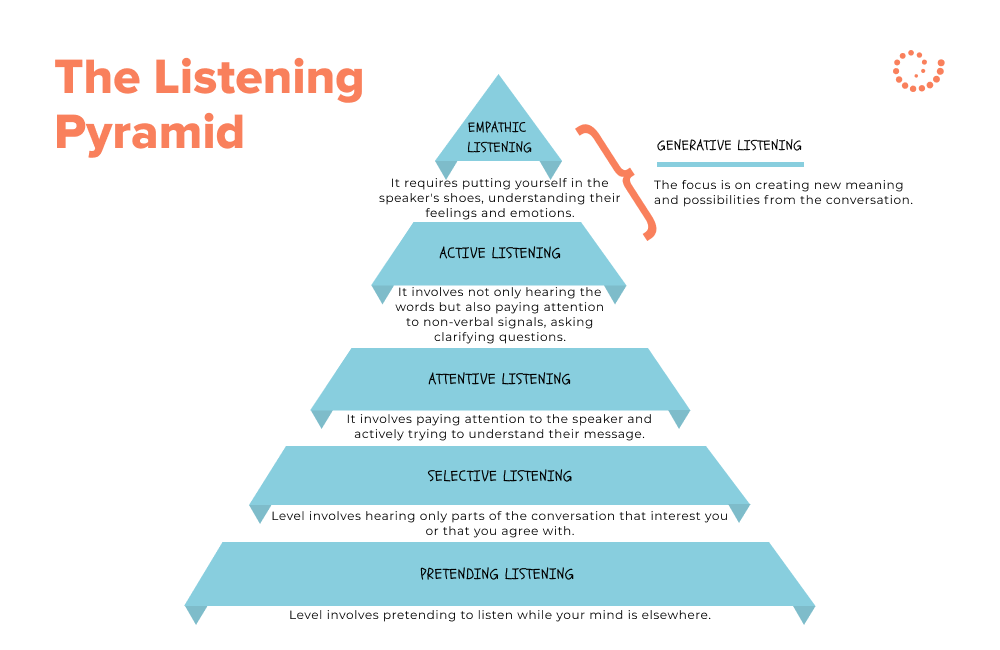
The Listening Pyramid: How to Improve Professional Relationships
Alla Dortman | March 19th, 2024
Have you ever sat at lunch with colleagues when one of them starts telling a story that doesn’t interest you? You sit there nodding your head, but your mind wanders?
This is called ignoring the audience. The worst kind of team communication experience. How well do you listen? How well do you listen to yourself? What types of listening are there? In this article, I will talk more about how to measure the efficiency and quality of professional communication.
A slightly better case would be if you were discussing your sprint tasks on a team call. The cameras are on. All OK for a while, but after a few minutes you notice most of the team is doing something else? Reading something on the second monitor, texting someone on their mobile, obviously not paying attention to what you’re talking about? These are situations where people are pretending to listen. We all pretend to listen sometimes.
The Listening Pyramid is a concept that outlines different levels of listening engagement and quality, from superficial to deeply meaningful interactions.
Let’s look at the classic model — the listening pyramid. The base of the pyramid is occupied by simpler forms of listening, and as we climb upwards, listening becomes deeper and more meaningful. In the classic model, 5 basic levels and one additional level are highlighted.
Let’s explain them from the simplest to the deepest involvement. As mentioned above, ignoring and pretending are at the bottom of the pyramid. Let us move to the next level, which in the model is called selective listening.

Selective listening means that you only listen to parts of the conversation that interest you or that you agree with.
For example, during a work meeting discussing a project, an employee may show selective listening, focusing only on the moments that relate to their immediate work and ignoring information that relates to their colleagues’ tasks. As a result, they may miss important updates or changes to the project that will later affect their work, requiring additional clarification from colleagues and corrections from managers.
In HR, I see this kind of listening all the time. Managers in IT usually think they can do several things at once: listen to information at a general meeting, chat with employees, check deadlines for tasks, reply to a wife’s message about a shopping list, and who knows what else. Unfortunately, multitasking is an illusion.
The quality of perception is drastically reduced. And it usually ends with questions: “Did I miss that when it was discussed? I disagree!” or “I still don’t understand what I’m supposed to do? Why is this necessary? When I find myself in the role of someone who is trying to share information, but who is only noticed for pretending to listen, I feel disappointment and even a kind of despair, guilt that I haven’t been able to interest my colleagues and convey the seriousness of the issue. The reality is that IT management needs to drastically improve the way it communicates.
But can only the party providing the information be blamed? We’ll talk about the responsibility of the parties a little later; for now, let’s look at other ways of listening.
The next level of listening — Attentive listening. This involves paying attention to the speaker and actively trying to understand the message.
For example, when an employee whose salary is lower than expected comes to me with a question, he listens very carefully to the answer because he is really interested in the question.
Attentive listening can also take place during the handover of tasks, for example when a colleague goes on annual leave and passes on his or her tasks to someone else. It’s important that the person taking over understands what’s being said because he or she will have to carry on doing the job.
Active listening involves listening not only to words but also to non-verbal cues, asking clarifying questions and giving feedback by letting the speaker know what we have understood.
An example of active listening might be a manager having a one-on-one meeting with a developer to discuss career development and teamwork expectations. In such a situation, the manager does much more than just listen. They ask questions to clarify details and actively reflect on what they have heard, checking that they have understood correctly. But that’s not all – the manager also pays attention to how the employee is behaving, what emotions they are showing, and tries to understand their real aspirations and goals. Such an approach shows deep respect for the employee’s opinion and creates the conditions for honest communication.
Empathic Listening — this is the fifth and deepest level and involves putting yourself in the speaker's shoes, understanding their feelings and emotions and responding with empathy.
At Setronica, this kind of listening is characteristic of HR’s one-on-one meetings with an employee going through a difficult time. We don’t just listen, we really try to feel what the employee/developer is going through, react to their emotions and try to understand their experiences.
A good HR professional will ask questions that show sincere concern and a desire to help, not just fill out paperwork. Most of the time, we manage to create a confidential atmosphere where the employee feels heard and valued, which not only helps to solve personal problems, but also strengthens the corporate culture of mutual support and understanding.
Having explained the 5 levels of the listening pyramid, let’s see what generative listening looks like in real life. An additional term that would ideally fit as 6 levels in our pyramid is generative listening.
Generative listening — this is a format where the focus is on creating new meaning and possibilities from the conversation.
I have many examples of how communicating with colleagues has given new meaning. This is how this blog came about. In a wonderful moment in a conversation with our Brand Executive, I gained confidence that my HR expertise could strengthen the company’s position in the market. Talking about HR in the age of AI is an essential topic for every HR department out there.
Exploring the listening pyramid not only opens up the diversity of approaches to perceiving information, but also emphasizes the importance of the responsibility of each participant in communication. The responsibility for the quality of the dialogue lies not only with the listener, but also with the speaker. Inattention or lack of involvement in the conversation often results in the loss of important information, and improper presentation of material can make it difficult for the other person to understand.
Taking responsibility for communication means actively working on your listening and speaking skills. It’s not just about being attentive and focused, it’s also about being able to communicate your ideas in an interesting, clear and structured way. Every time we choose a deeper level of listening, we not only improve understanding, but also help to create a trusting and open atmosphere in the team.
Being aware of one’s own role in the communication process and striving to improve one’s ability to listen actively and empathetically are key elements of successful communication. Understanding and being able to connect, recognising the importance of each opinion in the dialogue – this is what makes conversations truly fruitful and inspiring for new achievements and ideas.
FAQ
Organizations can foster active listening by offering workshops and training sessions focused on communication skills, encouraging team-building activities that require attentive listening, and promoting feedback mechanisms where employees can share their experiences and challenges related to listening. Leadership modeling active listening in their interactions also sets a positive example. Common barriers include distractions, multitasking, preconceived notions, and emotional biases. To overcome these, organizations can create distraction-free environments, emphasize the importance of focus during conversations, encourage open-mindedness, and provide emotional intelligence training to help employees manage personal biases and emotions effectively.
Yes, digital tools and technology can enhance listening skills by providing platforms for virtual meetings that include features such as real-time transcription, note-taking apps that help in summarizing discussions, and training apps that offer exercises in active and empathetic listening. These tools can support the development and practice of listening skills in a remote or hybrid work environment.
Join Our Team

Alla Dortman
HRD, Certified career coach
Discover more about Setronica and explore exciting career opportunities by visiting our dedicated career page.
Related
Recent Posts
- How to Efficiently Scale Your Startup’s Tech Stack for Maximum Growth
- Shine in Your Interview: 3 Dos and Don’ts to Prove Your Competence with Confidence
- Elevator Pitch: How to “Sell” Yourself in One Minute
- 9 Best Places to Find Free Datasets for Your Next Project
- 9 Key Measures to Protect Digital Assets and Ensure Data Integrity
Categories
SETRONICA
Setronica is a software engineering company that provides a wide range of services, from software products to core business applications. We offer consulting, development, testing, infrastructure support, and cloud management services to enterprises. We apply the knowledge, skills, and Agile methodology of project management to integrate software development and business objectives effectively and efficiently.
